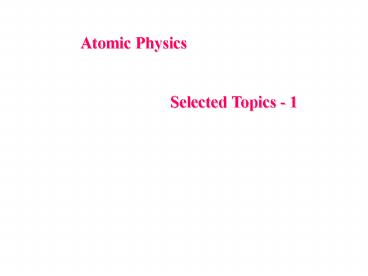Atomic Physics - PowerPoint PPT Presentation
Title:
Atomic Physics
Description:
Atomic Physics Selected Topics - 1 An atom is not an atom atom from the Greek a-tomos not-divisible 1897 J. J. Thomson discovered the electron. – PowerPoint PPT presentation
Number of Views:67
Avg rating:3.0/5.0
Title: Atomic Physics
1
Atomic Physics Selected
Topics - 1
2
An atom is not an atom atom from the
Greek a-tomos ? not-divisible 1897 J. J.
Thomson discovered the electron.
3
J.J. Thomsons model of the atom (1904)
- A volume of positive charge - Electrons
embedded throughout the volume (plum pudding
model) This is a change from Newtons model of
the atom as a tiny, hard, indestructible sphere.
4
Rutherford, 1911 Planetary model - Based on
results of thin foil experiments
Positive charge is concentrated in the center of
the atom, called the nucleus. Electrons orbit the
nucleus like planets orbit the sun.
5
Scattering Experiments
(Film is shown in class)
6
Scattering Experiments
The source was a naturally radioactive material
(Polonium-210) that produced alpha
particles. Most of the alpha particles passed
though the foil. A few deflected from their
original paths. Some even reversed their
direction of travel.
http//micro.magnet.fsu.edu/electromag/java/ruther
ford/ http//www.physics.upenn.edu/courses/gladne
y/phys351/classes/Scattering/Rutherford_Scattering
.html
7
Difficulties with the Rutherford Model
Atoms emit certain discrete characteristic
frequencies of electromagnetic radiation. The
Rutherford model is unable to explain this
phenomenon.
8
Difficulties with the Rutherford Model
Rutherfords electrons are undergoing a
centripetal acceleration and so should radiate
electromagnetic waves of the same frequency. The
radius should steadily decrease as this radiation
is given off. The electron should eventually
spiral into the nucleus, but it doesnt.
9
Emission Spectra
- A gas at low pressure has a voltage applied to
it. - A gas emits light characteristic of the gas.
- When the emitted light is analyzed with a
spectrometer, a series of discrete bright lines
is observed. - Each line has a different wavelength and color.
- This series of lines is called an emission
spectrum.
10
Examples of Visible Emission Spectra
Lines (wavelengths) in the ultraviolet and
infrared are also observed.
11
The wavelengths of hydrogens visible spectral
lines can be found from RH is the Rydberg
constant. RH 1.097 373 2 x 107 m-1 n is an
integer, n 1, 2, 3, The spectral lines
correspond to different values of n.
12
The Balmer Series (hydrogen) has lines whose
wavelengths are given by the preceding
equation. Examples of spectral lines n 3, ?
656.3 nm n 4, ? 486.1 nm











![L 34 Modern Physics [1] PowerPoint PPT Presentation](https://s3.amazonaws.com/images.powershow.com/7125701.th0.jpg?_=20150905079)








![L 33 Modern Physics [1] PowerPoint PPT Presentation](https://s3.amazonaws.com/images.powershow.com/7602675.th0.jpg?_=201602121011)










